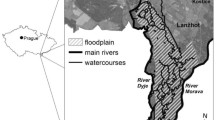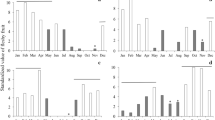Abstract
Given appropriate ecological and social conditions, natural selection should favor individuals that can concentrate their reproductive events to a particular time of the year that offers high opportunities for infant survivorship. Previous studies on births in Alouatta caraya in Northern Argentina revealed the existence of a peak during the dry season—a period with scarcity of food resources—in mainland gallery forest (G. E. Zunino, Extra 133: 1–10, 1996). The time of conception and the period of independence of the offspring are positively correlated with precipitation, temperature and availability of food. Offspring became independent from their mothers when the availability of resources was high, and conception coincided with the peak of fruit production. Our goal was to examine patterns of birth seasonality in Alouatta caraya in flooded forest on an island in Northern Argentina for comparison with the mainland population. Both sites are at similar latitudes, but differ in forest type. The results indicate that the availability of new and mature leaves is more consistent throughout the year in the flooded forest (p<0.05); however, there was no difference in the availability of fleshy fruits between sites (p>0.05). The pattern of births differed between the gallery forest and the flooded forest (2-way Anova, p<0.001). In the flooded forest births occurred throughout the year, which supports the contentions that howlers do not have a fixed birth season and that the observed variation in the timing of births appears to represent a facultative behavioral response to changes in food availability.
Similar content being viewed by others
References
Borries, C., Koenig, A., and Winkler P. (2001). Variation of life history traits and mating patterns in female langur monkeys (Semnopithecus entellus). Behav. Ecol. Sociobiol. 50(5): 391-402.
Brockett, R. C., Horwich, R. H., and Jones, C. B. (2000). Reproductive seasonality in the Belizean black howling monkey (Alouatta pigra). Neot. Primates 8(4): 136-138.
Brown, A. D., and Zunino, G. E. (1994). Hábitat, distribución y problemas de conservación de los Primates de la Argentina. Vida Silvestre Neotrop. 3(1): 30-40.
Butynski, T. M. (1988). Guenon birth seasons and correlates with rainfall and food. In Gautier-Hion, A., Bourliere, F., Gautier, J. P., and Kingdon, J. (eds.), A Primate Radiation: Evolutionary Biology of the African Guenons, Cambridge University Press, Cambridge, UK, pp. 284-322.
Caughley, G. (1977). Analysis of Vertebrate Populations, Wiley, New York.
Chapman, C. A., and Balcomb, S. R. (1998). Population characteristics of howlers: Ecological conditions or group history. Int. J. Primatol. 19(3): 385-403.
Clarke, M. R. (1983). Infant-killing and infant disappearance following male takeovers in a group of free-ranging howling monkeys (Alouatta palliata) in Costa Rica. Am. J. Primatol. 5(3): 241-247.
Clarke, M. R., and Glander, K. E. (1984). Female reproductive success in a group of free-ranging howling monkeys (Alouatta palliata) in Costa Rica. In Small, M. F. (ed.), Female Primates: Studies by Women Primatologists, Alan R. Liss, New York, pp. 159-173.
Colillas, O., and Coppo, J. (1978). Breeding Alouatta caraya in Centro Argentino de Primates. In Chivers, D. J., and Lane Petter W. (eds.), Recent Advances in Primatology, Academic Press, London, pp. 201-214.
Crockett, C. M., and Rudran, R. (1987a). Red howler monkey birth data. I: Seasonal variation. Am. J. Primatol. 13(4): 347-368.
Crockett, C. M., and Rudran, R. (1987b). Red howler monkey birth data. II: Interannual, habitat, and sex comparisons. Am. J. Primatol. 13(4): 369-384.
Dallmeier, F. (1992). Long-term monitoring of biological diversity in tropical forest areas: Methods for establishment and inventory of permanents plots. In MAB Digest II, UNESCO, París.
De la Torre, S., Campos, F., and de Vries, T. (1995). Home range and birth seasonality of Saguinus nigricollis graelsii in Ecuadorian Amazonia. Am. J. Primatol. 37: 39-56.
Di Bitetti, M. S., and Janson, C. H. (2000). When will the stork arrive? Patterns of birth seasonality in Neotropical primates. Am. J. Primatol. 50: 109-130.
Dittus, W. P. J. (1977). The social regulation of population density and age-sex distribution in the toque monkey. Behaviour 63: 281-322.
Eskuche, U., and Fontana, J. L. (1996). La vegetación de las islas argentinas del Alto Paraná. F. Bot. Geobotan. Corrent. 11: 1-15.
Estrada, A. R. (1982). Survey and census of howler monkeys (Alouatta palliata) in the rain forest of “Los Tuxtlas,” Veracruz, Mexico. Am. J. Primatol. 2: 363-372.
Fedigan, L. M., and Rose, L. M. (1995). Interbirth interval variation in three sympatric species of neotropical primates. Am. J. Primatol. 37: 9-24.
Fedigan, L. M., Rose, L. M., and Avila, R. M. (1998). Growth of mantled howler groups in a regenerating Costa Rican dry forest. Int. J. Primatol. 19(3): 405-432.
Franceschi, E. A., and Lewis, J. P. (1979). Notas sobre la vegetación del valle santafesino del río Paraná (República Argentina). Ecosur 6(11): 55-82.
Garber, P. A. (1987). Foraging strategies among living primates. Ann. R. Anthropol. 16: 339-364.
Gevaerts, H. (1992). Bith seasons of Cercopithecus, Cercocebus and Colobus in Zaire. F. Primatol. 59: 105-113.
Glander, K. E. (1980). Reproduction and population growth in free-ranging mantled howling monkeys. Am. J. Phys. Anthropol. 53: 25-36.
Gonzalez, V. (1998). Análisis florístico-estructural de los árboles de la selva de inundación del río Paraná en el NE de la Argentina. Seminario De Integración, Estudios Superiores De Buenos Aires (inedit).
Gould, L., Sussman, R. W., and Sauther, M. L. (1999). Natural disasters and primate populations: The effects of a 2-year drought on a naturally occurring population of ring-tailed lemurs (Lemur catta) in southwestern Madagascar. Int. J. Primatol. 20(1): 69-84.
Koenig, A., Borries, C., Chalise, M. K., and Winkler, P. (1997). Ecology, nutrition, and timing of reproductive event in an Asian primate, the Hanuman langur (Presbystis entellus). J. Zool. (Lond.) 243: 215-235.
Lancaster, J. B., and Lee, R. B. (1965). The annual reproductive cycle in monkeys and apes. In DeVore, I. (ed.), Primate Behavior: Field Studies of Monkeys and Apes, Holt, Rinehort and Winst, New York, pp. 486-513.
Lee, P. C. (1987). Nutrition, fertility and maternal investment in primates. J. Zool.( Lond.) 213: 409-422.
Lindburg, D. G. (1987). Seasonality of reproduction in primates. In Mitchell, G., and Erwin, J. (eds.), Comparative Primate Biology. 2B: Behavior, Cognition, Motivation, Alan R. Liss, New York, pp. 167-218.
Milton, K. (1980). The Foraging Strategy of Howler Monkeys: A Study in Primate Economics, Columbia University Press, New York.
Milton, K. (1982). Dietary quality and demographic regulation in a howler monkey population. In Leigh, E. G., Rand, A. S., and Windsor, D. M. (eds.), The Ecology of a Tropical Forest: Seasonal Rhythms and Long-Term Changes, Smithsonian Institution Press, Washington, DS0, pp. 273-289.
Milton, K. (1998). Physiological ecology of howlers (Alouatta): Energetic and digestive considerations and comparison with the Colobinae. Int. J. Primatol. 19(3): 513-548.
National Research Council (U.S.). Committee on Nonhuman Primates. Subcommittee on Conservation of Natural Populations. (1981). Techniques for the Study of Primate Population Ecology, National Academy Press, Washington, DN0.
Neville, M. K. (1972). The population structure of red howler monkeys (Alouatta seniculus) in Trinidad and Venezuela. Folia Primatol. 17: 56-86.
Placci, L. G. (1995). Estructura y comportamiento fenológico en relación a un gradiente hídrico en bosques del este de formosa, Doctoral Thesis, Universidad Nacional de La Plata (inedit).
Popolizio, E. (1977). Contribución a la geomorfología de Corrientes. Geociencia, VII y VIII, UNNE, Resistencia, Chaco.
Rowell, T. E., and Richards, S. M. (1979). Reproductive strategies of some African monkeys. J. Mammal. 60: 58-69.
Rudran, R. (1973). The reproductive cycles of two subspecies of purple-faced langurs (Presbytis senex) with relation to environmental factors. F. Primatol. 19: 41-60.
Rumiz, D. I. (1990). Alouatta caraya. Population density and demography in northern Argentina. Am. J. Primatol. 21: 279-294.
Rumiz, D. I., Zunino, G. E., Obregozo M. L., and Ruiz, J. C. (1986). Alouatta caraya: Habitat and Resource Utilization in Northern Argentina. In Taub, D. M., and King, F. A. (eds.), Current Perspectives in Primate Social Dynamics, Van Nostrand Rehinold, New York, pp. 175-193.
Siegel, S., and Castellan, N. J. (1988). Nonparametric Statistics for the Behavioral Sciences, McGraw-Hill, New York.
Sokal, R. R., and Rohlf, F. J. (1995). Biometry, W. H. Freeman, New York.
Strier, K. B., Mendes, S. L., and Santos, R. R. (2001). Timing of births in sympatric brown howler monkeys (Alouatta fusca clamitans) and northern muriquis (Brachyteles arachnoides hypoxanthus). Am. J. Primatol. 55(2): 87-100.
Takahashi, H. (2002). Female reproductive parameters and fruit availability: Factors determining onset of estrus in Japanese macaques. Am. J. Primatol. 57(3): 141-153.
Thorington, R. W., Ruiz, J. C., and Eisenberg, J. F. (1984). A study of a black howling monkey (Alouatta caraya) population in Northern Argentina. Am. J. Primatol. 6: 357-366.
van Schaik, C. P., and van Noordwijk, M. A. (1985). Interannual variability in fruit abundance and the reproductive seasonality in Sumatran long-tailed macaques (Macaca fascicularis). J. Zool. (Lond.) (A) 206: 533-549.
Wright, P. C. (1999). Lemur traits and Madagascar ecology: Coping with an island environment. Yearb. Phys. Anthropol. 42: 1-42.
Zar, J. H. (1984). Biostatiscal Analysis, Prentice-Hall, Upper Saddle River, NJ.
Zunino, G. E. (1986). Observaciones sobre el comportamiento territorial del mono aullador negro (Alouatta caraya). Bol. Primatol. Arg. 4(1): 36-52.
Zunino, G. E. (1989). Hábitat, dieta y actividad del mono aullador negro (Alouatta caraya) en el noreste de la Argentina. Bol. Primatol. Latinoame. 1(1): 74-97.
Zunino, G. E. (1996). Reproducción del mono aullador negro Alouatta caraya (Primates, Cebidae) en el noreste de la Argentina. Museo Argentino de Ciencias Naturales. Extra 133(Nueva Serie): 1-10.
Zunino, G. E., González, V., Kowalewski, M., and Bravo, S. P. (2001). Alouatta caraya. Relations among habitat, density and social organization. Primate Repr. 61: 37-46.
Author information
Authors and Affiliations
Corresponding author
Rights and permissions
About this article
Cite this article
Kowalewski, M., Zunino, G.E. Birth Seasonality in Alouatta caraya in Northern Argentina. International Journal of Primatology 25, 383–400 (2004). https://doi.org/10.1023/B:IJOP.0000019158.45628.4a
Issue Date:
DOI: https://doi.org/10.1023/B:IJOP.0000019158.45628.4a




